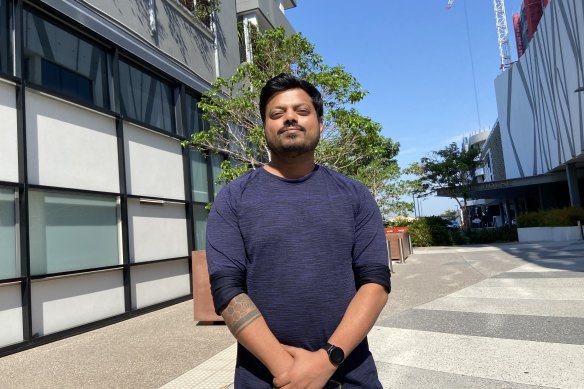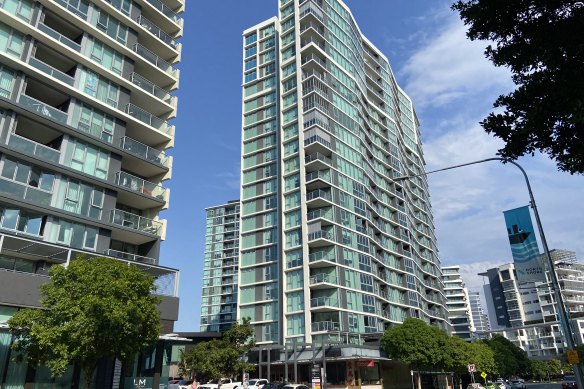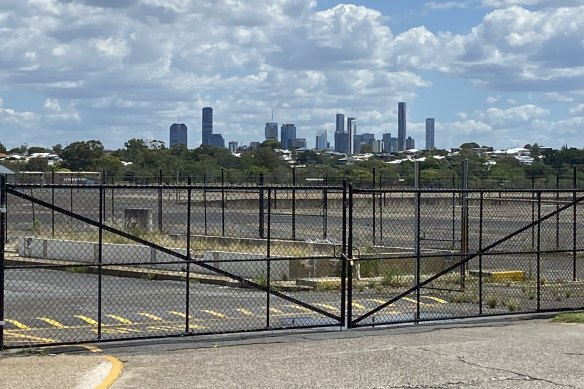This was published 1 year ago
Feel the burn: In these towers, the windows provide more than a view
By Tony Moore
Pravesh Kumar has been living in an apartment with big glass windows, in a modern residential tower next to the Brisbane River, for 10 months.
It is part of the burgeoning Northshore Hamilton Precinct, where old wharves and warehouses are being transformed into much-needed housing and an athletes’ village for the 2032 Olympic and Paralympic Games.
In an overheated real estate market, Kumar is luckier than many. But he still wonders whether subtropical Brisbane is the place for the glass towers in the blazing sun.

Pravesh Kumar says his apartment, with its large glass windows, is “very hot” and requires the air-conditioning on all the time.Credit: Tony Moore
His home can be very hot – and expensive to cool.
“We always have to have the air-conditioning on,” Kumar said.
“That makes a difference, but it’s still very hot.”
Another resident, Ben Ramen, has lived in the area since 2007. He described residents feeling the “burn” at different times of day depending on whether their unit faced east or west.
“We call it ‘morning burn’ or ‘evening burn’,” Ramen said, pointing to an apartment facing west.
“For this building, it’s ‘evening burn’.”

The Hamilton Northshore precinct has become a test case for balancing developer profits with sustainability and liveability.Credit: Tony Moore
Ramen said developers should be required to mitigate the impact of sunlight and heat on residents, regardless of whether they were owner-occupiers or renters.
He gave the example of towers built with shutters, even if they partly obscured the view.
“That is because of the sun,” Ramen said.
Queensland University of Technology researchers have examined the trade-off between potential profits and heat management at Northshore Hamilton and also Brisbane City.
According to their research, a $1.19 billion increase in sales revenue in Hamilton would come with a 4-5 degree increase in temperature at the “urban heat island”.

Old industrial land at Hamilton is being transformed into housing and an athletes village for the 2032 Brisbane Olympic and Paralympic Games.Credit: Tony Moore
“Our simulation shows that a trade-off between economic and ecological factors has to be made,” QUT’s urban heat specialist Matthias Tuczek and his team reported.
The 2022 research was completed for Economic Development Queensland, which manages Hamilton Northshore, and has acknowledged residents’ complaints about the heat.
In Brisbane, the Buildings that Breathe guide, introduced with the 2014 City Plan, encourages developers to include outdoor spaces, allow for natural ventilation, and use eaves and green cover to provide shade and help bring temperatures down.
When the guidelines were introduced, Brisbane City Council estimated the city had 300 “comfortable” days – when artificial heating or cooling was not required – and 65 “uncomfortable” days. It was based on a mean temperature of 25 degrees.
In 2023, the Brisbane mean temperature was 27.2 degrees, with mean temperatures above 25 degrees in seven months of the year.
Dr Tony Matthews, from Griffith University’s Queensland Heat Health Community of Practice, applauded QUT’s work on making Northshore Hamilton more sustainable and liveable.
“That is the cutting-edge sort of work that is beginning to become available for commercial research,” Matthews said.
He said it was wrong for development to be guided by business considerations alone, as was traditionally the case.
“You have the developer who is paying for the building, you have the architect who is designing the building more or less to the developer’s specifications and budget, and you have the planning authority who will bring some rules to bear on it,” Matthews said.
“You risk ending up with a building that meets everybody’s criteria. But what will not be central to anyone’s conversation is the experience of the occupants of the building.”
This article was produced in collaboration with the Australian Science Media Centre, with support from the Walkley Foundation-administered Meta Public Interest Journalism Fund.